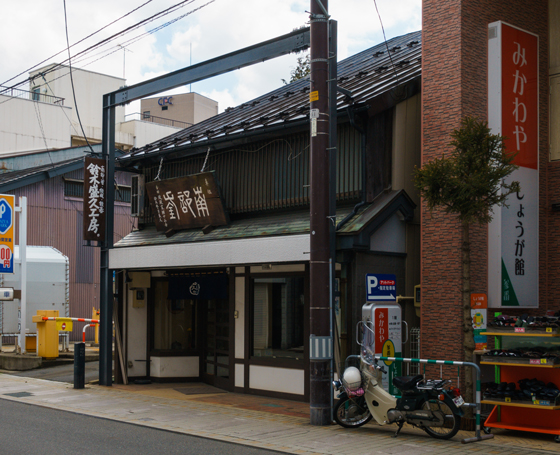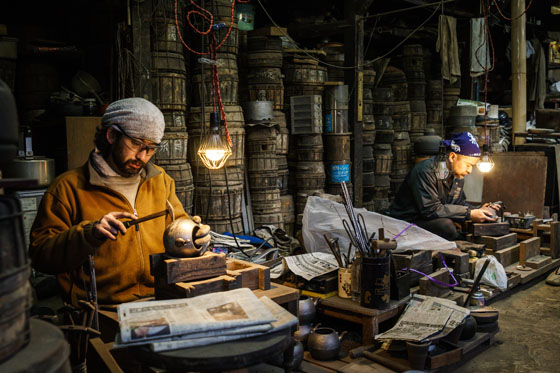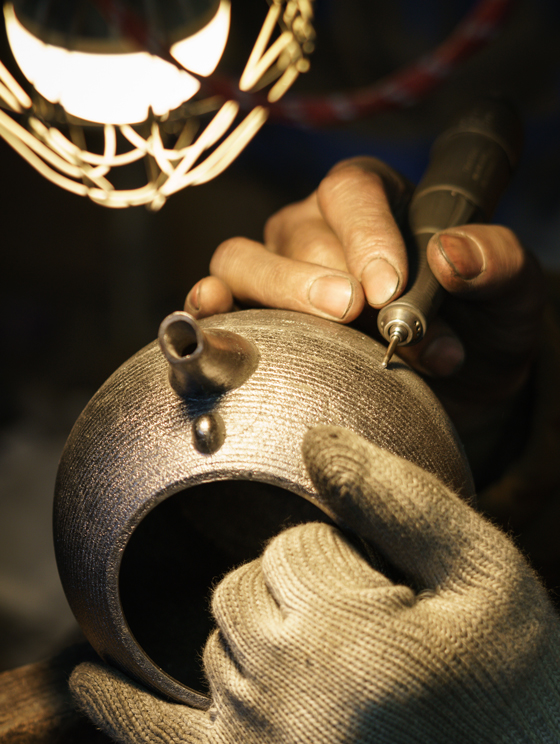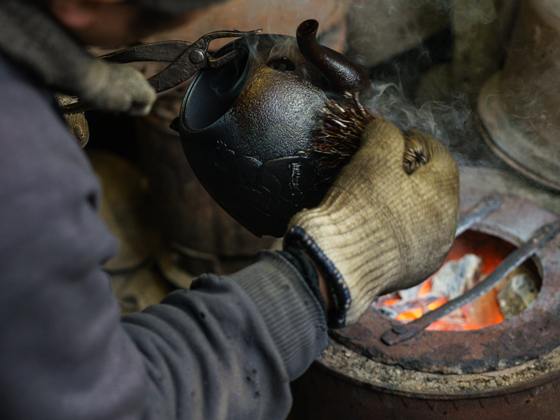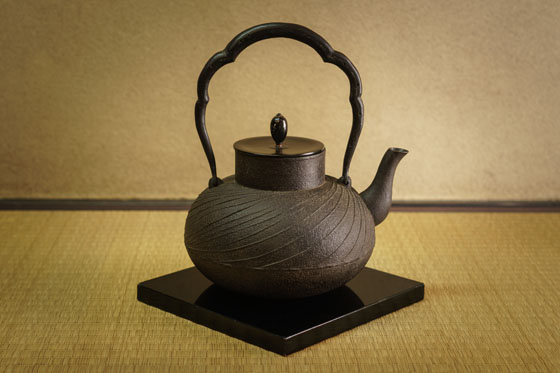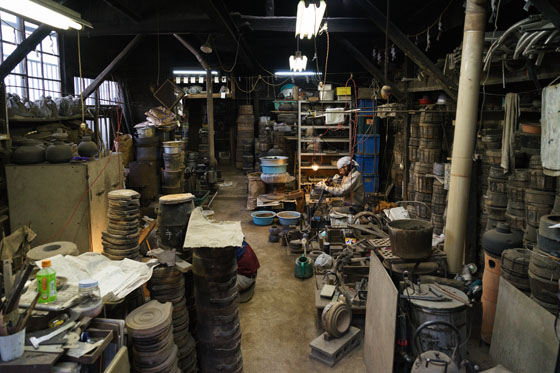Japan Stories: Suzuki Morihisa Studio
Texte par 25portraits
Berlin, Allemagne
26.06.17
In the first installment of Japan Stories, a new independent series on craftspeople working in Japan, Suzuki Morihisa Studio, one of the oldest and most famous family workshops for Nanbu Tekki (or ironworks), opens its doors.
Shiiko Kumagai (15th generation) and her son Shigeo Suzuki (16th generation) in their studio, in Morioka
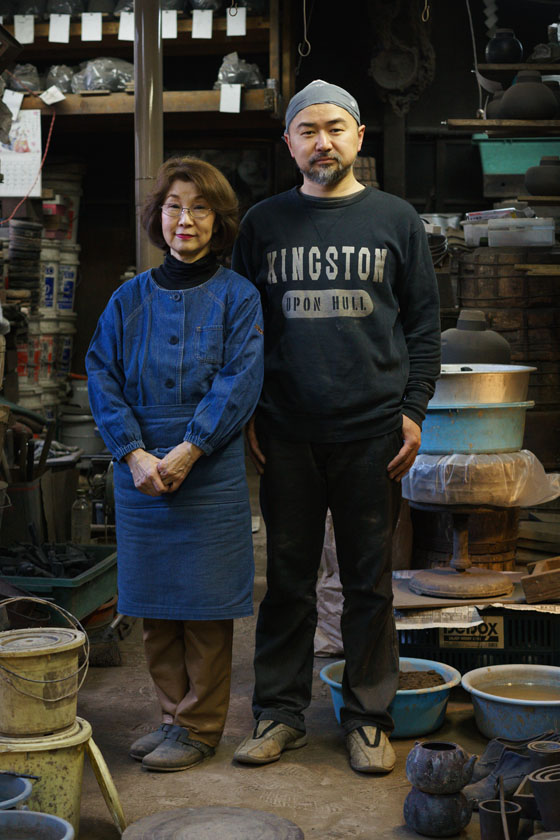
Shiiko Kumagai (15th generation) and her son Shigeo Suzuki (16th generation) in their studio, in Morioka
×Suzuki Morihisa in Morioka, Iwate Prefecture, is a 15th generation family business for cast ironworks (Nanbu Tekki), dating back to 1625.
Shigeo Suzuki, of the henceforward 16th generation, talks about the workshop’s history and the current situation.
Preparing the mold with different textures of sand and clay (top). Chanoyugama (iron pot or kettle), often used in tea ceremonies (bottom)
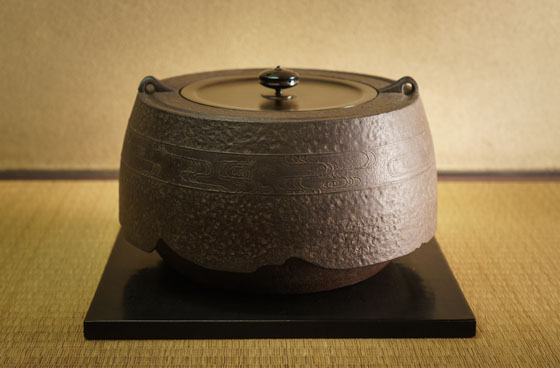
Preparing the mold with different textures of sand and clay (top). Chanoyugama (iron pot or kettle), often used in tea ceremonies (bottom)
×Please tell us a little bit about the rich history of Suzuki Morihisa.
In the Edo Period, there was a feudal lord of the Nanbu clan from Yamanashi Prefecture who liked art. Here in Iwate, iron, sand, charcoal, and lacquer were abundant. These materials being available in one place made Iwate ideal for cast ironwork, and craftsmen were brought in from around Japan. My ancestor was from Yamanashi just like the Nanbu clan, and was called by the lord to join him in Iwate. That was the beginning. That was about 390 years ago. Now we are in the 15th generation.
When and how did you decide to continue this tradition?
Our tradition passes from parent to child, so when my mother took on the role, I began to think that my turn would be next.
I have two siblings, but I am the one that likes art. So from high school age I realised it would be my path in life. So I went to Tokyo Geijitsu Daigaku (Tokyo University of the Arts) for university. At art school I studied related crafts, as I was aware of my future path. Maybe I should have come back here right after graduating from university, but I wanted to try out various things in Tokyo as a working adult. When I turned 35 it seemed like a good time to transition and come back here. Now I have been working here for 9 years.
Outside view of Suzuki Morihisa’s studio (top). Workplace with dozens of stacked molds (bottom)
It seems that Japanese craftspeople also position themselves against the philosophy of steadily using up goods for mere consumption.
Yes, that’s true. Even when our moulds break, we reuse the materials again. It is good for the environment, but it is not really something that we came up with. It has been this way for generations. In that way we are very compatible with this modern era. Perhaps since the post war era it has been like that, but recently many young people have become more ecologically conscious. I think our style is compatible with the ecological consciousness of the modern era.
Please tell us a little bit about the current situation of Nanbu Tekki (cast ironworks).
Besides this Nanbu area, the other major iron-producing area is Yamagata. In smaller areas like Takaoka in Toyama and in other locations, there are small workshops making iron implements for tea ceremonies, especially in Kyoto, Osaka, and even Tokyo.
In terms of current conditions, we have been very busy for the last 5 or 6 years. We are grateful for this, and in fact, we cannot even make enough products to keep up with demand right now.
One of the main causes is the demand in China. We previously had customers from Asian countries including Taiwan and Malaysia, but around 2010 or 2011, Nanbu Tekki became incredibly popular in China. It goes well with Chinese tea. We have had Chinese customers placing quite large orders with us. (…)
Right now there is about a 3-year lag time in fulfilling orders. Other places also have 1 year lag times from ordering to shipment. We simply don’t have enough products. That's the current state of things.
Removing burrs on a tea kettle after casting (top). Coloring process using urushi (bottom)
How long does it take to design, mould, cast and finish a piece of work?
It takes about a month, basically. We make the casting form over a month. Pour the iron in the center, and then it finishes in another month. So with four of us we make about 40 items each two months. We only make about 200 to 250 items each year. I would like to be able to make a few more each year to fill our customer’s demands.
We feel that you have an extraordinarily keen and quite unusual sense for the shape of your works.
We didn’t have any set rules for what forms to make, and generations ago we were just making the sort of things we found beautiful. Some variations and forms that emerged have become our style. There is a lot of variation between each generation of craftsman, though.
The 13th generation, our most famous ancestor was very involved in the tea ceremony, and thus the wabi-sabi philosophy, and his pieces reflect this. But he also did various modern pieces as well. There is really a great variety. The 14th generation worked as a professor in Tokyo for a long time, and was influenced by Italian art. My mother, the 15th generation, was the first woman. Her works are light, delicate and feminine. She wasn’t aiming for that, it just naturally turned out that way and her work is viewed in that manner. So we really don’t have a set style. We are about upholding a very high level of quality more than any set style.
Where do you find inspiration for your work?
I think my answer is different from what my mother would say, but in my case, I do not really think about iron. I lived in Tokyo and worked in all sorts of design and graphic design. I get a lot of inspiration from other types of art and items. Architecture, sculpture, movies, graphic posters, etc. all inspire me. Culture is also an inspiration. I do not really look at past cast iron things for inspiration though. My predecessors were so amazing that if I look too much at their work, I get influenced, and it would not be interesting if I just copied their works. So I really try not to look at cast iron work – to avoid being influenced by it.
This is an excerpt of the interview with Shigeo Suzuki held in March 2017 in Morioka, Iwate.
Photos: Katharina Zettl and Uwe Roettgen
....
About 25portraits
25portraits is a book and documentary project about the inspiring workshops, materials, production processes, products and personalities of 25 craftspeople from all fields of Japanese arts and crafts.





